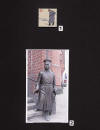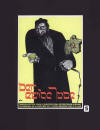
The Captain of Koepenick
As I was walking with my wife, Yvonne
during the Fall of 2006 through the town of Oranienburg in Germany
looking for her grandparent’s former store that they had to leave behind
in the late 30’s on account of Nazi persecutions (see the article on the
Rickshaw Website, “A small Photograph shows the Way”), we happened to
see a local post office on the opposite side of the street that was only
a few steps away from the train station. Being a philatelist at heart, I
walked inside to see the operation of a typical German Post office (Die
Deutsche Post). While inside looking at all the new stamps on display, I
stumbled across a postage stamp depicting a character I have not heard
mentioned since my childhood days. It was an immediate flashback that
almost brought tears from my eyes. Case in point discussed later in the
report.
The €0.55 stamp yours truly is referring
to, designed by Carsten Wolff, and released September 7, 2006,
commemorated the play “Der Hauptmann von Koepenick” (1931) from Carl
Zuckmeyer, whose mother was Jewish, with an illustration of the featured
character in uniform (Figure one). The play was based on a true story of
an unemployed shoemaker and ex-prisoner who in his make-shift uniform in
1906 seized command over ten German soldiers while taking over the City
Hall of Koepenick (Figure two). By writing the story, the goal of Zuckmeyer was to drive the German bureaucracy and the German Reich
military to ridiculousness.
Just prior to Kristallnacht in 1938 when Aryan doctors in Germany were
not allowed to treat Jewish patients anymore, this writer, at the age of
four developed an acute case appendicitis. While screaming from severe
pain, my mother was frantically looking for a Jewish doctor. Luckily she
found a clinic in the outskirts of Berlin that had a Jewish doctor on
their staff, and who was able to perform an immediate appendectomy
(Figure three).
While I was recuperating in the clinic, a lot of relatives and friends
came to visit and showered me with presents; among them “Ein Hampelmann”
(a two dimensional jumping jack constructed from wood, approx. 10 inch
in height) shown in Figure four, symbolizing the legendary figure, “Der
Hauptmann von Koepenick.” This all happened during the period when
anti-Semitism had already begun to run rampant all over Europe (Figure
five), and also a time when it became imperative for Jews to seek refuge
in another country. We all remember what followed.
Growing up in Shanghai was not an easy thing especially for our
parents. For many refugees there were days when there was no money to
buy food, let alone providing any toys for their children to play with.
The “Hampelmann” that my parents was able to salvage from Germany was
the only toy I had, and although it took a lot of abuse that can be
expected from a child, like the detached bell that rang when the string
attached to the Hampelmann was pulled up and down, and the many scratch
marks, it found its way all the way to the United States. It may have
been the last time before leaving Shanghai that I heard the name “Der
Hauptmann von Koepenick” mentioned by my parents and grandmother.
Today, this memorable toy with its name so very deeply etched in my
memory, is mounted in a frame the way it arrived in the United States
sixty years ago, and is hanging on the wall above my computer where I
can see it every day. It will always remind me of my childhood, and the
struggle that our parents endured while protecting us from hunger and
disease.
Reference: Literature Wissen ( literature-wissen.net/der-hauptmann-vom-koepenick.htm
Deutsche Post)
The stamp may be obtained by sending a donation to Temple Knesset
Israel, 1260 No. Vermont Ave., Los Angeles, CA 90029

Fig.1&2


